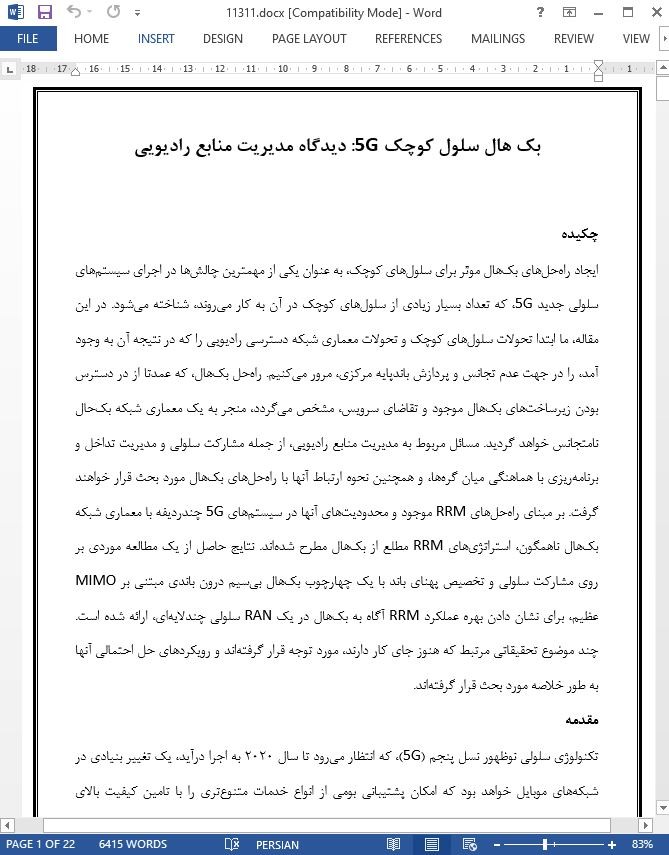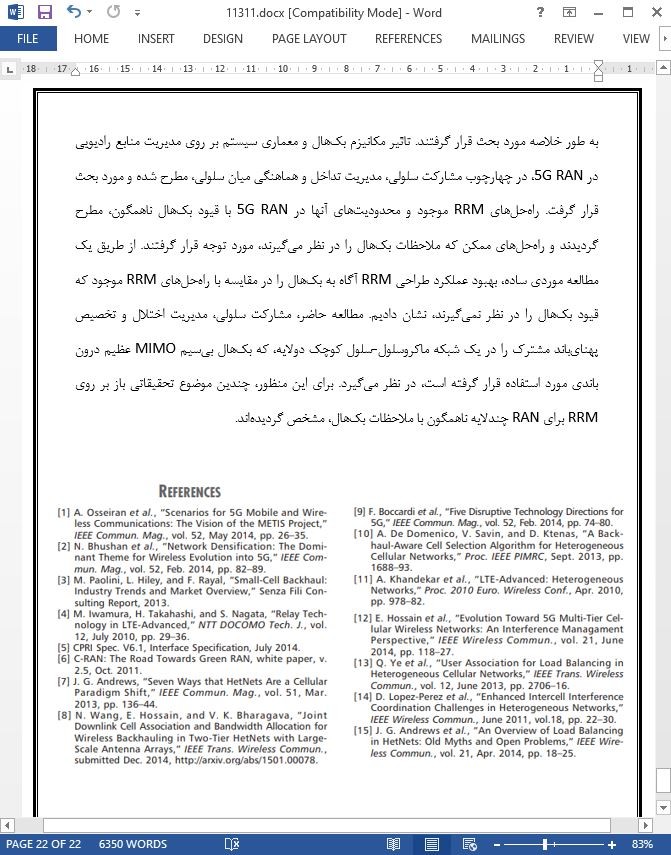
بک هال سلول کوچک 5G: ديدگاه مديريت منابع راديويی
چکيده
ايجاد راه حل هاي بک هال موثر براي سلول هاي کوچک، به عنوان يکي از مهمترين چالش ها در اجراي سيستم-هاي سلولي جديد 5G، که تعداد بسيار زيادي از سلول هاي کوچک در آن به کار مي روند، شناخته مي شود. در اين مقاله، ما ابتدا تحولات سلول هاي کوچک و تحولات معماري شبکه دسترسي راديويي را که در نتيجه آن به وجود آمد، را در جهت عدم تجانس و پردازش باندپايه مرکزي، مرور مي کنيم. راه حل بک هال، که عمدتا از در دسترس بودن زيرساخت هاي بک هال موجود و تقاضاي سرويس، مشخص مي گردد، منجر به يک معماري شبکه بک حال نامتجانس خواهد گرديد. مسائل مربوط به مديريت منابع راديويي، از جمله مشارکت سلولي و مديريت تداخل و برنامه ريزي با هماهنگي ميان گره ها، و همچنين نحوه ارتباط آنها با راه حل هاي بک هال مورد بحث قرار خواهند گرفت. بر مبناي راه حل هاي RRM موجود و محدوديت هاي آنها در سيستم هاي 5G چندرديفه با معماري شبکه بک هال ناهمگون، استراتژي هاي RRM مطلع از بک هال مطرح شده اند. نتايج حاصل از يک مطالعه موردي بر روي مشارکت سلولي و تخصيص پهناي باند با يک چهارچوب بک هال بي سيم درون باندي مبتني بر MIMO عظيم، براي نشان دادن بهره عملکرد RRM آگاه به بک هال در يک RAN سلولي چندلايه اي، ارائه شده است. چند موضوع تحقيقاتي مرتبط که هنوز جاي کار دارند، مورد توجه قرار گرفته اند و رويکردهاي حل احتمالي آنها به طور خلاصه مورد بحث قرار گرفته اند.
مقدمه
تکنولوژي سلولي نوظهور نسل پنجم (5G)، که انتظار مي رود تا سال 2020 به اجرا درآيد، يک تغيير بنيادي در شبکه هاي موبايل خواهد بود که امکان پشتيباني بومي از انواع خدمات متنوع تري را با تامين کيفيت بالاي خدمات (QoS)، فراهم مي آورد. هرچند که هيچ اجماع جهاني اي بر روي تعريف 5G وجود ندارد، اما به طور گسترده اي پذيرفته شده است که در مقايسه با سيستم هاي سلولي فعلي، شاخص هاي عملکرد کليدي (KPIها) يک سيستم سلولي 5G بايد از 1000 برابر ترافيک داده، 10-100 برابر ارتباطات بيشتر، عمرباطري 10 برابر طولاني تر، زمان تاخير زير ميلي ثانيه، نرخ دسترسي 1Gb/s در هنگام جابه جايي و نرخ دسترسي 10Gb/s در حالت ثابت، برخوردار باشد [1].
نتيجه گيري
ما در ابتدا به مرور سيرتکامل سلول هاي کوچک و تاثير آن بر روي تکامل معماري RAN به سوي ناهمگوني و پردازش باندپايه متمرکز در 5G، پرداختيم. سيستم بک هال براي سلول کوچک، به شکل قابل توجهي بر روي عملکرد RAN در سيستم هاي 5G تاثير مي گذارد. راه حل هاي بک هال/فرانت هال باسيم و بي سيم موجود که مي توانند براي پشتيباني از RAN و C-RAN چندلايه 5G مورد استفاده قرار گيرند، به طور خلاصه مورد بحث قرار گرفتند. تاثير مکانيزم بک هال و معماري سيستم بر روي مديريت منابع راديويي در RAN 5G، در چهارچوب مشارکت سلولي، مديريت تداخل و هماهنگي ميان سلولي، مطرح شده و مورد بحث قرار گرفت. راه-حل هاي RRM موجود و محدوديت هاي آنها در RAN 5G با قيود بک هال ناهمگون، مطرح گرديدند و راه حل-هاي ممکن که ملاحظات بک هال را در نظر مي گيرند، مورد توجه قرار گرفتند. از طريق يک مطالعه موردي ساده، بهبود عملکرد طراحي RRM آگاه به بک هال را در مقايسه با راه حل هاي RRM موجود که قيود بک هال را در نظر نمي گيرند، نشان داديم. مطالعه حاضر، مشارکت سلولي، مديريت اختلال و تخصيص پهناي باند مشترک را در يک شبکه ماکروسلول-سلول کوچک دولايه، که بک هال بي سيم MIMO عظيم درون باندي مورد استفاده قرار گرفته است، در نظر مي گيرد. براي اين منظور، چندين موضوع تحقيقاتي باز بر روي RRM براي RAN چندلايه ناهمگون با ملاحظات بک هال، مشخص گرديده اند.
Abstract
Developing efficient backhauling solutions for small cells is considered as one of the most significant challenges in the rollout of the upcoming 5G cellular systems where massive numbers of small cells will be deployed. In this article, we first review small cell evolutions and the consequent radio access network architecture evolution toward heterogeneity and centralized baseband processing. The backhaul solution, which is mainly determined by the availability of existing backhaul infrastructures and service demand, will lead to a heterogeneous backhaul network architecture. Radio resource management issues including cell association, and interference management and scheduling with inter-node coordination, as well as how they are related to backhaul solutions are discussed. Based on the existing RRM solutions and their limitations in multi-tier 5G systems with heterogeneous backhaul network architecture, backhaul- aware RRM strategies are envisioned. Results from a simple case study of joint cell association and bandwidth allocation with a massive MIMO-based in-band wireless backhauling framework are presented to demonstrate the performance gain with backhaul-aware RRM in a multi-tier cellular RAN. Several related open research issues are highlighted, and possible solution approaches are briefly discussed.
INTRODUCTION
The upcoming fifth generation (5G) cellular technology, which is expected to be rolled out by 2020, is going to be a paradigm shift of mobile networking offering native support to more diverse service types with quality of service (QoS) provisioning. Even though there is no global consensus on the definition of 5G, it is widely accepted that compared to the current cellular systems, the key performance indicators (KPIs) of 5G cellular should include 1000 times higher data traffic, 10–100 times more connections, 10 times longer battery lifetime, sub-millisecond latency, 1 Gb/s rate with mobility, and 10 Gb/s stationary access rate [1].
CONCLUSION
We have first surveyed the evolution of small cells and its impact on the RAN architecture evolution toward heterogeneity and centralized baseband processing in 5G. The backhauling system for small cell will significantly impact the RAN performance in 5G systems. Existing wired and wireless backhauling/fronthauling solutions that can be used to support 5G multi-tier RAN and C-RAN have been briefly discussed. The impact of backhauling mechanism and system architecture on the radio resource management in 5G RAN have been discussed in the context of cell association, interference management, and inter-cell coordination. Existing RRM solutions and their limitations in 5G RAN with heterogenous backhaul constraints have been discussed, and possible solutions which take backhaul considerations into account have been envisioned. We have demonstrated the performance gain of backhaul-aware RRM design when compared to existing RRM solutions ignoring the backhaul constraints through a simple case study. This study considers joint cell association, interference management, and bandwidth allocation in a two-tier macrocell-small cell network where in-band massive MIMO wireless backhaul is adopted. To this end, several open research issues on RRM for heterogeneous multi-tier RAN with backhaul considerations have been outlined.
چکيده
مقدمه
سيرتکاملی سلول های کوچک در RAN سلولي، تکامل سلول های کوچک
سيرتکاملی معماري RAN: RANهاي چندلايه و C-RAN
بک هال سلول های کوچک 5G: مسائل مديريت منابع راديويي
راه حل های بک هال براي سلول های کوچک 5G
ملاحظات 5G RAN RRM با بک هال
راه حل های موجود براي مديريت منابع و محدوديت هاي آنها
انتخاب RAT و اشتراک سلول
مديريت رابط ها
برنامه ريزی و هماهنگي ميان سلولی
بک هال بی سيم درون باند مبتنی بر MIMO عظيم برای سلول های کوچک متراکم: يک مطالعه موردی
موضوعات باز برای تحقيق
نتيجه گيری
ABSTRACT
INTRODUCTION
EVOLUTION OF SMALL CELLS IN CELLULAR RAN
EVOLUTION OF SMALL CELLS
RAN ARCHITECTURE EVOLUTION: MULTI-TIER RAN AND C-RAN
BACKHAULING 5G SMALL CELLS: RADIO RESOURCE MANAGEMENT ISSUES BACKHAULING SOLUTIONS FOR 5G SMALL CELLS
5G RAN RRM CONSIDERATIONS WITH BACKHAULING
MASSIVE-MIMO-BASED IN-BAND WIRELESS BACKHAULING FOR DENSE SMALL CELLS: A CASE STUDY
OPEN RESEARCH ISSUES
CONCLUSION
- اصل مقاله انگلیسی با فرمت ورد (word) با قابلیت ویرایش
- ترجمه فارسی مقاله با فرمت ورد (word) با قابلیت ویرایش، بدون آرم سایت ای ترجمه
- ترجمه فارسی مقاله با فرمت pdf، بدون آرم سایت ای ترجمه



